Reynolds RD. Use of the Mogen clamp for neonatal circumcision. Amer
Fam Physician 1996; 54:177-82.
The Mogen clamp was invented in 1954 by Rabbi Harry Bronstein, a Brooklyn
mohel. For many years it was used only in Jewish ritual circumcision in
a ceremony called a bris. In the past ten years or so, US physicians are
using the clamp more frequently in medical settings for newborn circumcision.
The Mogen clamp will only open to 3.0 mm, minimizing the chance of trapping
the glans. It locks closed with great force along a narrow crush line. It
does not cut, it only crushes. It is not a guillotine as is commonly thought.
"Mogen" is Yiddish for "shield" - the Mogen clamp shields
the glans from the scalpel.
The pictures below are from my article and show the steps in Mogen circumcision.
It is imperative that physicians unfamiliar with the technique read the
entire article and enlist the instruction of an experienced practitioner
before attempting the procedure.
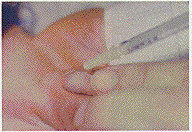
The first step in any circumcision is appropriate anesthesia. Dorsal
penile nerve block using about 1 ml of 1% lidocaine thru a 30 guage needle
renders the procedure virtually painless. With this technique, most newborns
sleep thru the procedure.
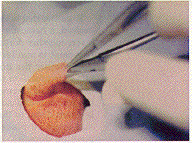
The dorsal tip of the foreskin is grasped with a fine hemostat for traction,
and another fine hemostat is used to open the plane between the glans and
the foreskin all the way back to the corona. Care is taken to keep the tip
of the dissecting hemostat tenting the skin at all times. This keeps the
hemostat out of the urethra. The ventral area is not dissected to avoid
bleeding from the artery in the frenulum.
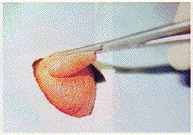
The first hemostat is removed and replaced on the dorsal midline with its
tip about3 mm short of the corona, and locked in place.

The Mogen clamp is opened fully. Clamps should be checked periodically to
insure that the opening is no more than 3.0 mm, and sent for repair or discarded
if they do open wider.
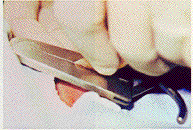
A key step in Mogen circumcision is the safe placement of the clamp.
To push the glans back out of the way, the surgeon's thumb and index finger
pinch the foreskin below the dorsal hemostat. The Mogen clamp is then slid
across the foreskin from dorsal to ventral, following along the same angle
as the corona. The hollow side of the clamp faces the glans. More foreskin
is removed dorsally than ventrally.
(I have observed surgeons improperly placing the clamp side-to-side. This
is very dangerous as excessive traction on the frenulum can rotate the glans
dorsally, drawing the meatus into the clamp and leading to inadvertent partial
glans amputation...)
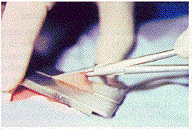
Before locking the Mogen clamp shut, the glans is manipulated to be sure
it is free of the clamp's jaws. If it is, the clamp is locked. Note the
triangular shape of the foreskin to be excised since the corona angle is
followed.
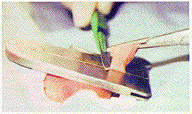
Once locked, the foreskin is excised flush with the flat surface of the
clamp with a 10-blade scalpel.
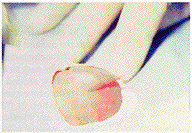
The clamp is left on for a few moments to insure hemostasis, then unlocked
and removed. The crush line covers the glans fully with penile shaft skin.
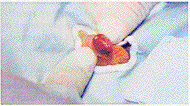
The glans is liberated by thumb traction at the 3 and
9 o'clock positions that pulls the crush line apart.

The picture above shows the immediate result.
The picture below shows the final result 10 days postop.

Many thanks to Mary Jo Philhower at Mercy Hospital Anderson, Cincinnati,
for photography.
The Mogen clamp is sold by:
The Mogen Instrument Company
437 Crown St.
Brooklyn, NY 11225
(716) 604-8833
Go to this Site
Back To Methods
[If you do not see a blue menu bar on the right, click here. You are at a link from "Different Methods/Video".]











